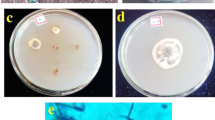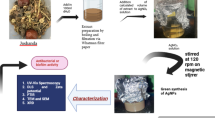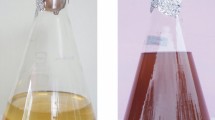Abstract
The primary objective of the current investigation was the biosynthesis of Phy-AgNPs by the endophytic fungus Phyllosticta owaniana (extracted from Abrus precatorius) and the evaluation of the secondary metabolites from the ethyl acetate extract of P. owaniana cultivated by submerged fermentation. Utilizing bioanalytical strategies, Phy-AgNPs were characterized. The UV–visible spectrophotometer analysis revealed an absorption spectrum with a peak at 420 nm, thus validating the Phy-AgNPs synthesis. The FTIR analysis revealed peaks correlating to various potential functional groups, suggesting that Phy-AgNPs have been reduced and capped. SEM-EDAX and HR-TEM analyses demonstrated the spherical shape of Phy-AgNPs, and the 3 keV EDAX analysis confirmed the existence of silver atoms. XRD analyses showed the Phy-AgNPs crystalline structure. The size and the stability of synthesized Phy-AgNPs (65.81 nm) were measured by DLS and Zeta potential studies. While the ethyl acetate extract was analyzed with GC–MS and FTIR for secondary metabolites. The synthesized Phy-AgNPs showed effective antibacterial activity against Pseudomonas aeruginosa (15.1 ± 0.17 mm, 10 mg/mL), while the antifungal activity of Phy-AgNPs inhibited the growth of Candida albicans extremely efficiently (12.16 ± 0.28 mm, 10 mg/mL). Phy-AgNPs were evaluated for a variety of biomedical properties in which they showed significant activity. In a cell viability assay using the MTT assay, Phy-AgNPs exhibited a cytotoxic impact of up to 30.67% and 34.53% when 200 µg/mL were detected. In both in vitro and in vivo anti-inflammatory examinations, nanoparticles (NPs) exhibited a significant anti-inflammatory effect. These findings support the pharmaceutical and biomedical properties of the synthesized Phy-AgNPs.


























Similar content being viewed by others
Data availability
Not applicable.
References
Abdel-Azeem A, Nada AA, O’Donovan A, Thakur VK, Elkelish A (2020) mycogenic silver nanoparticles from endophytic Trichoderma atroviride with antimicrobial activity. J Renew Mater 8:171–185. https://doi.org/10.32604/jrm.2020.08960
Ajah HA, Hassan AS, Aja HA (2018) Extracellular biosynthesis of AgNPs using Fusarium Graminearum and their antimicrobial activity. J Glob Pharm Technol 683–689, ISSN: 0975-8542
Awad MA, Eid AM, Elsheikh TMY, Al-Faifi ZE, Saad N, Sultan MH, Selim S, Al-Khalaf AA, Fouda A (2022) Mycosynthesis, characterization, and mosquitocidal activity of silver nanoparticles fabricated by Aspergillus niger Strain. J Fungi 8:396. https://doi.org/10.3390/jof8040396
Azmath P, Baker S, Rakshith D, Satish S (2016) Mycosynthesis of silver nanoparticles bearing antibacterial activity. Saudi Pharm J 24:140–146. https://doi.org/10.1016/j.jsps.2015.01.008
Bagur H, Poojari CC, Melappa G, Rangappa R, Chandrasekhar N, Somu P (2020) Biogenically synthesized AgNPs using endophyte fungal extract of Ocimum tenuiflorum and evaluation of biomedical properties. J Clust Sci 31:1241–1255. https://doi.org/10.1007/s10876-019-01731-4
Barkhade T (2018) Extracellular biosynthesis of AgNPs using fungus Penicillium species. Int J Res Granthaalayah. https://doi.org/10.5281/zenodo.1164148
Bauer AW, Kirby WMM, Sherris JC, Turck M (1966) Antibiotic susceptibility testing by a standardized single disk method. Am J Clin Pathol 45:493–496. https://doi.org/10.1093/ajcp/45.4_ts.493
Bharathidasan R, Panneerselvam A (2012) Biosynthesis and characterization of silver nanoparticles using endophytic fungi Aspergillus concius, Penicillium janthinellum and Phomosis sp. IJPSR https://doi.org/10.13040/IJPSR.0975-8232.3(9).3163-69
Bhattacharjee S, Debnath G, Das AR (2017) Characterization of silver nanoparticles synthesized using an endophytic fungus, Penicillium oxalicum having potential antimicrobial activity. Adv Nat Sci Nanosci Nanotechnol 8:045008. https://doi.org/10.1088/2043-6254/aa84ec
Chandankere R, Chelliah J, Subban K, Shanadrahalli VC, Parvez A, Zebed HM, Sharma YC, Qi X (2020) Pleiotropic functions and biological potentials of silver nanoparticles synthesized by an endophytic fungus. Front Bioeng Biotechnol 8:95. https://doi.org/10.3389/fbioe.2020.00095
Das SK, Behera S, Patra JK, Thatoi H (2019) Green synthesis of sliver nanoparticles using Avicennia officinalis and Xylocarpus granatum extracts and in vitro evaluation of antioxidant, antidiabetic and anti-inflammatory activities. J Cluster Sci 30:1103–1113. https://doi.org/10.1007/s10876-019-01571-2
Devi NN, Prabakaran JJ (2014) Bioactive metabolites from an endophytic fungus Penicillium sp. isolated from Centella asiatica. CREAM 4:34–43. https://doi.org/10.5943/cream/4/1/3
Devi LS, Joshi SR (2015) Ultrastructures of AgNPs biosynthesized using endophytic fungi. J Microscopy Ultrastr Int J Nanomater Biostr. https://doi.org/10.1016/j.jmau.2014.10.004
Devi LS, Bareh DA, Joshi SR (2013) Studies on Biosynthesis of Antimicrobial Silver Nanoparticles Using Endophytic Fungi Isolated from the Ethno-medicinal Plant Gloriosa superba L. Proc Natl Acad Sci India Sect B Biol Sci 84:1091–1099. https://doi.org/10.1007/s40011-013-0185-7
Dinesh B, Monisha N, Shalini HR, Prathap GK, Poyya J, Shantaram M, Hampapura JS, Karigar CS, Joshi CG (2021) (2022) Antibacterial activity of AgNPs synthesized using endophytic fungus Penicillium cinnamopurpureum. Spectrosc Latt. https://doi.org/10.1080/00387010.2021.2010764
Farsi M, Farokhi S (2018) Biosynthesis of Antibacterial Silver Nanoparticles by Endophytic Fungus Nemania sp. isolated from Taxus baccata L. (Iranian Yew). Zahedan J Res Med Sci. https://doi.org/10.5812/zjrms.57916
Fouda A, Awad MA, AL-Faifi ZE, Gad ME, Al-Khalaf AA, Yahya R, Hamza MF (2022a) Aspergillus flavus-mediated green synthesis of silver nanoparticles and evaluation of their antibacterial, anti-candida, acaricides, and photocatalytic activities. Catalysts 12:462. https://doi.org/10.3390/catal12050462
Fouda A, Hassan SE, Eid AM, Abdel-Rahman MA, Hamza MF (2022b) Light enhanced the antimicrobial, anticancer, and catalytic activities of selenium nanoparticles fabricated by endophytic fungal strain, Penicillium crustosum EP-1. Sci Rep 12:11834. https://doi.org/10.1038/s41598-022-15903-2
Gemishev O, Panayotova M, Gicheva G, Mintcheva N (2022) Green synthesis of stable spherical monodisperse silver nanoparticles using a cell-free extract of Trichoderma reesei. Materials 15:481. https://doi.org/10.3390/ma15020481
Ghorbanzadeh B, Mansouri M, Hemmati A, Naghizadeh B, Mard S, Rezaie A (2015) A study of the mechanisms underlying the ant-inflammatory effect of ellagic acid in carrageenan-induced paw edema in rats. Indian J Pharmacol 47:292. https://doi.org/10.4103/0253-7613.157127
Gill H, Vasundhara M (2019) Isolation of taxol producing endophytic fungus Alternaria brassicicola from non-Taxus medicinal plant Terminalia arjuna. World J Microbiol Biotechnol 35:74. https://doi.org/10.1007/s11274-019-2651-8
Giridasappa A, Ismail SM, Rangappa D (2021) Antioxidant, antiproliferative and antihemolytic properties of phytofabricated AgNPs using Simarouba glauca and Celastrus paniculatus extracts. Appl Nanosci 11:2561–2576. https://doi.org/10.1007/s13204-021-02084-z
Govindappa M, Farheen H, Chandrappa CP, Channabasava RRV, Raghavendra VB (2016) Mycosynthesis of AgNPs using extract of endophytic fungi, Penicillium species of Glycosmis mauritiana, and its antioxidant, antimicrobial, anti-inflammatory and tyrokinase inhibitory activity. Adv Natl Sci Nanosci Nanotechnol. https://doi.org/10.1088/2043-6262/7/3/035014
Govindappa M, Lavanya M, Aishwarya P (2020) Synthesis and characterization of endophytic fungi, Cladosporium perangustum mediated AgNPs and their antioxidant, anticancer and nano-toxicological Study. Bionanosci 10:928–941. https://doi.org/10.1007/s12668-020-00719-z
Govindappa M, Dj M, Vinaykiya V, Bhoomika V, Dutta S, Pawar R, Raghavendra VB (2022) Screening of antibacterial and antioxidant activity of biogenically synthesized silver nanoparticles from Alternaria alternata, endophytic fungus of Dendrophthoe falcata-a parasitic plant. Bionanoscience 12:128–141. https://doi.org/10.1007/s12668-021-00932-4
Gunathilake K, Ranaweera K, Rupasinghe H (2018) In vitro anti-inflammatory properties of selected green leafy vegetables. Biomedicines 6:107. https://doi.org/10.3390/biomedicines6040107
Gupta AK, Parasar D, Sagar A, Choudhary V, Chopra BS, Garg R, Khatri N (2015) Analgesic and anti-Inflammatory properties of Gelsolin in acetic acid induced writhing, tail immersion and carrageenan induced paw edema in Mice. PLoS ONE 10:e0135558. https://doi.org/10.1371/journal.pone.0135558
Hateet RR (2020) GC-MS Analysis of extract for endophytic fungus Acremonium coenophialum and its antimicrobial and antidiabetic. Res J Pharm Technol 13:119. https://doi.org/10.5958/0974-360X.2020.00024.4
Hu X, Kandasamy S, Tieyan J, Myeong-Hyeon W (2019) Mycosynthesis, characterization, anticancer and antibacterial activity of silver nanoparticles from endophytic fungus Talaromyces purpureogenus. Int J Nanomed 14:3427–3438. https://doi.org/10.2147/IJN.S200817
Janakiraman V, Govindarajan K, Magesh CR (2019) Biosynthesis of silver nanoparticles from endophytic fungi, and its cytotoxic activity. BioNanoSci 9:573–579. https://doi.org/10.1007/s12668-019-00631-1
Jayaram H, Marigowda V, Thara Saraswathi KJ (2021) Secondary metabolite production and terpenoid biosynthesis in endophytic fungi Cladosporium cladosporioides isolated from wild Cymbopogon martinii (Roxb) Wats. Microbiol Res. https://doi.org/10.3390/microbiolres12040059
Kanjana M, Kanimozhi G, Udayakumar R, Panneerselvam A (2019) GC-MS analysis of bioactive compounds of endophytic fungi Chaetomium globosum, Cladosporium tenuissimum and Penicillium janthinellum. J Biomed Pharm Sci 2:123
Krishnaraj C, Jagan EG, Rajasekar S (2010) Synthesis of silver nanoparticles using Acalypha indica leaf extracts and its antibacterial activity against water borne pathogens. Colloids Surf B 76:50–56. https://doi.org/10.1016/j.colsurfb.2009.10.008
Li G, He D, Qian Y, Guan B, Gao S, Cui Y, Yokoyama K, Wang L (2012) Fungus-mediated green synthesis of AgNPs using Aspergillus terreus. Int J Mol Sci. https://doi.org/10.3390/ijms13010466
Nallappan D, Fauzi AN, Krishna BS, Kumar BP, Reddy AVK, Syed T, Reddy CS, Yaacob NS, Rao PV (2021) Green biosynthesis, antioxidant, antibacterial, and anticancer activities of AgNPs of Luffa acutangula leaf extract. BioMed Res Int. https://doi.org/10.1155/2021/5125681
Netala VR, Kotakadi VS, Bobbu P, Gaddam SA, Tartt V (2016a) Endophytic fungal isolate mediated biosynthesis of AgNPs and their free radical scavenging activity and antimicrobial studies. 3 Biotech. https://doi.org/10.1007/s13205-016-0433-7
Netala VR, Bethu SM, Pushpalatha B, Baki VB, Aishwarya S, Rao V, Tartte V (2016b) Biogenesis of AgNPs using endophytic fungus Pestalotiopsis microspora and evaluation of their antioxidant and anticancer activities. Int J Nanomed. https://doi.org/10.2147/IJN.S112857
Nischitha R, Shivanna MB (2021) Metabolite fingerprinting, in vitro antimicrobial and antioxidant activities and in-silico docking in Alloteropsis cimicina and its endophytic fungus Penicillium pinophilum. Mol Biol Rep 48:4021–4037. https://doi.org/10.1007/s11033-021-06410-0
Nischitha R, Shivanna MB (2022) Screening of secondary metabolites and antioxidant potential of endophytic fungus Penicillium citrinum and host Digitaria bicornis by spectrophotometric and electrochemical methods. Arch Microbiol 204:206. https://doi.org/10.1007/s00203-022-02795-z
Noah N (2019) Green synthesis: Characterization and application of silver and gold nanoparticles. In: Green Synthesis, Characterization and Applications of Nanoparticles. Elsevier, pp 111–135
Popli D, Anil V, Subramanyam AB, Namratha MN, Ranjitha VR, Saroja N (2018) Rao, Rai RV, Govindappa M (2018) Endophyte fungi, Cladosporium species-mediated synthesis of AgNPs possessing in vitro antioxidant, anti-diabetic and anti-Alzheimer activity. Artif Cells Nano Med Biotechnol. https://doi.org/10.1080/21691401.2018.1434188
Prasher IB, Dhanda RK (2017) GC-MS analysis of secondary metabolites of endophytic Nigrospora sphaerica isolated from Parthenium hysterophorus. Int J Pharm Sci Rev Res 44:217–223
Qiu M, Xie R, Shi Y et al (2010) Isolation and identification of endophytic fungus SX01, a red pigment producer from Ginkgo biloba L. World J Microbiol Biotechnol 26:993–998. https://doi.org/10.1007/s11274-009-0261-6
Rafie HME, Hamed MAA (2014) Antioxidant and anti-inflammatory activities of AgNPs biosynthesized from aqueous leaves extracts of four Terminalia species. Adv Natl Sci Nanosci Nanotechnol. https://doi.org/10.1088/2043-6262/5/3/035008
Rahi DK, Parmar AS (2014) Mycosynthesis of AgNPs by an endophytic Penicillium species of Aloe vera root, evaluation of their antibacterial and antibiotic enhancing activity, 46–51, ISSN 2277–3851
Rahim AK, Mahmoud SY, Ali AM (2016) Extracellular biosynthesis of AgNPs using Rhizopus stolonifera, Saudi. J Biol Sci. https://doi.org/10.1016/j.sjbs.2016.02.025
Rahman MM, Islam MB, Biswas M, Khurshid Alam AHM (2015) In vitro antioxidant and free radical scavenging activity of different parts of Tabebuia pallida growing in Bangladesh. BMC Res Notes. https://doi.org/10.1186/s13104-015-1618-6
Rajeshkumar S, Bharath LV, Geetha R (2019) Broad spectrum antibacterial silver nanoparticle green synthesis: Characterization, and mechanism of action. In: Green Synthesis, Characterization and Applications of Nanoparticles. Elsevier, pp 429–444
Ramalingmam P, Muthukrishnan S, Thangaraj P (2015) Biosynthesis of AgNPs using an endophytic fungus, Curvularialunata and Its antimicrobial potential. J Nanosci Nanoeng 241–247, http://www.aiscience.org/journal/jnn
Rani R, Sharma D, Chaturvedi M, Jp Y (2017) Green synthesis, characterization and antibacterial activity of AgNPs of endophytic fungi Aspergillus terreus. J Nanomed Nanotechnol. https://doi.org/10.4172/2157-7439.1000457
Ranjani S, Ahmed MS, MubarakAli D, Ramachandran C, Kumar NS (2020) Hemalatha S (2020) Toxicity assessment of AgNPs synthesized using endophytic fungi against nosacomial infection. Inorg Nano-Metal Chem. https://doi.org/10.1080/24701556.2020.1814332
Ross Hallett F (1994) Particle size analysis by dynamic light scattering. Food Res Int 27:195–198. https://doi.org/10.1016/0963-9969(94)90162-7
Seeram NP, Henning SM, Niu Y (2006) Catechin and caffeine content of green tea dietary supplements and correlation with antioxidant capacity. J Agric Food Chem 54:1599–1603. https://doi.org/10.1021/jf052857r
Seetharaman PK, Chandrasekaran R, Periakaruppan R, Gnanasekar S, Sivaperumal S, Abd-Elsalam KA, Valis M, Kuca K (2021) Functional attributes of myco-synthesized AgNPs from endophytic fungi: A new implication in biomedical applications. Biology. https://doi.org/10.3390/biology10060473
Sharma A, Sagar A, Rana J, Rani R (2022) Green synthesis of silver nanoparticles and its antibacterial activity using fungus Talaromyces purpureogenus isolated from Taxus baccata Linn. Micro Nano Syst Lett 10:2. https://doi.org/10.1186/s40486-022-00144-9
Singh T, Jyoti K, Patnaik A, Singh A, Chauhan R, Chandel SS (2017) Biosynthesis, characterization and antibacterial activity of AgNPs using an endophytic fungal supernatant of Raphanus sativus. J Genet Eng Biotechnol. https://doi.org/10.1016/j.jgeb.2017.04.005
Sonbol H, Mohammed A, Korany SM (2022) Soil fungi as biomediator in silver nanoparticles formation and antimicrobial efficacy. IJN 17:2843–2863. https://doi.org/10.2147/IJN.S356724
Soni N, Prakash S (2015) Antimicrobial and mosquitocidal activity of microbial synthesized AgNPs. Parasitol Res 114:1023–1030. https://doi.org/10.1007/s00436-014-4268-z
Titus D, James Jebaseelan Samuel E, Roopan SM (2019) Nanoparticle characterization techniques. In: Green Synthesis, Characterization and Applications of Nanoparticles. Elsevier, pp 303–319
Vane JR, Botting RM (1995) new insights into the mode of action of anti-inflammatory drugs. Inflamm Res 44:1–10. https://doi.org/10.1007/BF01630479
Vardhana J, Aparna A, Ramarajan S (2018) Synthesis and antibacterial activity of silver nanoparticles from endophytic fungi Phyllosticta Sp isolated from Amaranthus retroflexus - a plant weed. Int J Pharm Sci Rev Res 51:48–52
Vladár AE, Hodoroaba VD (2020) Characterization of nanoparticles by scanning electron microscopy. In: Characterization of Nanoparticles. Elsevier, pp 7–27
Yugandhar P, Haribabu R, Savithramma N (2015) Synthesis, characterization and antimicrobial properties of green-synthesised silver nanoparticles from stem bark extract of Syzygium alternifolium (Wt) Walp. 3 Biotech 5:1031–1039. https://doi.org/10.1007/s13205-015-0307-4
Zhang X-F, Liu Z-G, Shen W, Gurunathan S (2016) Silver nanoparticles: synthesis, characterization, properties, applications, and therapeutic approaches. IJMS 17:1534. https://doi.org/10.3390/ijms17091534
Zhao X, Zhou L, Riazajoka MS, Yan L, Jiang C, Shao D, Zhu J, Shi J, Huang Q (2017) Fungal AgNPs: synthesis, application and challenges. Crit Rev Biotechnol. https://doi.org/10.1080/07388551.2017.1414141
Acknowledgements
The authors appreciate the lab facilities provided by the Department of Microbiology at Kuvempu University, Karnataka, India, for providing laboratory facilities to conduct this research work and also thank Kuvempu University for financial support to carry out the research work. IADFAC Laboratories Pvt. Ltd. Bangalore, India, for providing facilities to perform GC–MS analysis; Head Center for Nanotechnology, University Agriculture Sciences (UAS), Raichur, Karnataka, India, for providing facilities to perform particle size analysis by dynamic light scattering (DLS) and Zeta potential; Department of Applied Sciences (Nanotechnology), Visvesvaraya Technological University, Bengaluru Region, Muddenahalli, Chikkaballapur, Karnataka, India; and Sophisticated Analytical Instrument Facility (SAIF) Karnatak University Dharwad, Karnataka, India, for providing facilities to perform FTIR,SEM- EDAX, and XRD; Indian Institute of Science, Bengaluru, Karnataka, India, for providing facilities to perform HR-TEM; Averin Biotech Labs, Bangalore, India., for providing facilities to perform the MTT assay.
Funding
This study received no specific funding from public, commercial, or not-for-profit funding agencies.
Author information
Authors and Affiliations
Contributions
MD-Laboratory Research Analysis and Manuscript Writing, MGT, NS-guide for anti-inflammatory activity experimentation and manuscript correction, AS-Manuscript Correction and Editing, NG-Phylogenetic Tree Analysis and Data Editing. SHV-manuscript correction and editing, TB-designee and research work modification.
Corresponding author
Ethics declarations
Conflict of interest
The authors declare that they have no competing interest.
Ethics approval
Approval numbers were consented by the office of Institutional Animal Ethical Committee (IAEC) (Reg. No: 123/PO/C/99/CPCSEA under the rules 5(a) of the “Breeding of experiments on animal (control and supervision rules 1998”, Ref: SSCPT/IAEC.Clear/152/2016–17)).
Additional information
Communicated by Yusuf Akhter.
Publisher's Note
Springer Nature remains neutral with regard to jurisdictional claims in published maps and institutional affiliations.
Rights and permissions
Springer Nature or its licensor (e.g. a society or other partner) holds exclusive rights to this article under a publishing agreement with the author(s) or other rightsholder(s); author self-archiving of the accepted manuscript version of this article is solely governed by the terms of such publishing agreement and applicable law.
About this article
Cite this article
Manjunatha, D., Megha, G.T., Nagaraju, S. et al. Eco-friendly synthesized silver nanoparticles from endophytic fungus Phyllosticta owaniana: KUMBMDBT-32 and evaluation of biomedical properties. Arch Microbiol 205, 217 (2023). https://doi.org/10.1007/s00203-023-03549-1
Received:
Revised:
Accepted:
Published:
DOI: https://doi.org/10.1007/s00203-023-03549-1




